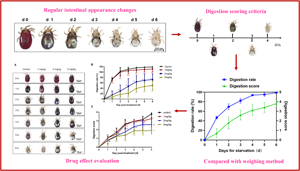Article contents
A blood digestion scoring method for poultry red mites, Dermanyssus gallinae
Published online by Cambridge University Press: 22 August 2022
Abstract

The poultry red mite (PRM), Dermanyssus gallinae, is one of the most detrimental ectoparasite on poultry farms worldwide. The blood fed on birds provides the mites with nutrition and energy for their activities, development and reproduction. In the evaluation of the efficacy of novel drugs or vaccines against PRMs, their effects on blood digestion are generally used as a key parameter. The blood digestion of haematophagous arthropods (including D. gallinae) is usually assessed by weighing; however, this method shows some limitations. The main objective of the present study was to develop a scoring method that can quickly and visually evaluate the blood digestion status of PRMs. A 0–4 point scoring criterion was established to describe the blood digestion status of D. gallinae based on the changes in appearance in the intestinal tract of PRMs during the blood digestion process. There was a good consistency between the results obtained by the blood digestion scoring and the weighing, indicating the reliability of this new method. The results obtained from volunteers were consistent with the results from researchers with low coefficient of variation, indicating that the scoring method has good practicability. The applicability of the scoring method was confirmed in an efficacy study, where it was found that doramectin could significantly inhibit the blood digestion of PRMs, lowering the blood digestion score.
- Type
- Research Article
- Information
- Copyright
- Copyright © The Author(s), 2022. Published by Cambridge University Press
Footnotes
Yuyun Ma and Qi Liu should be considered joint first authors.
References
- 1
- Cited by





